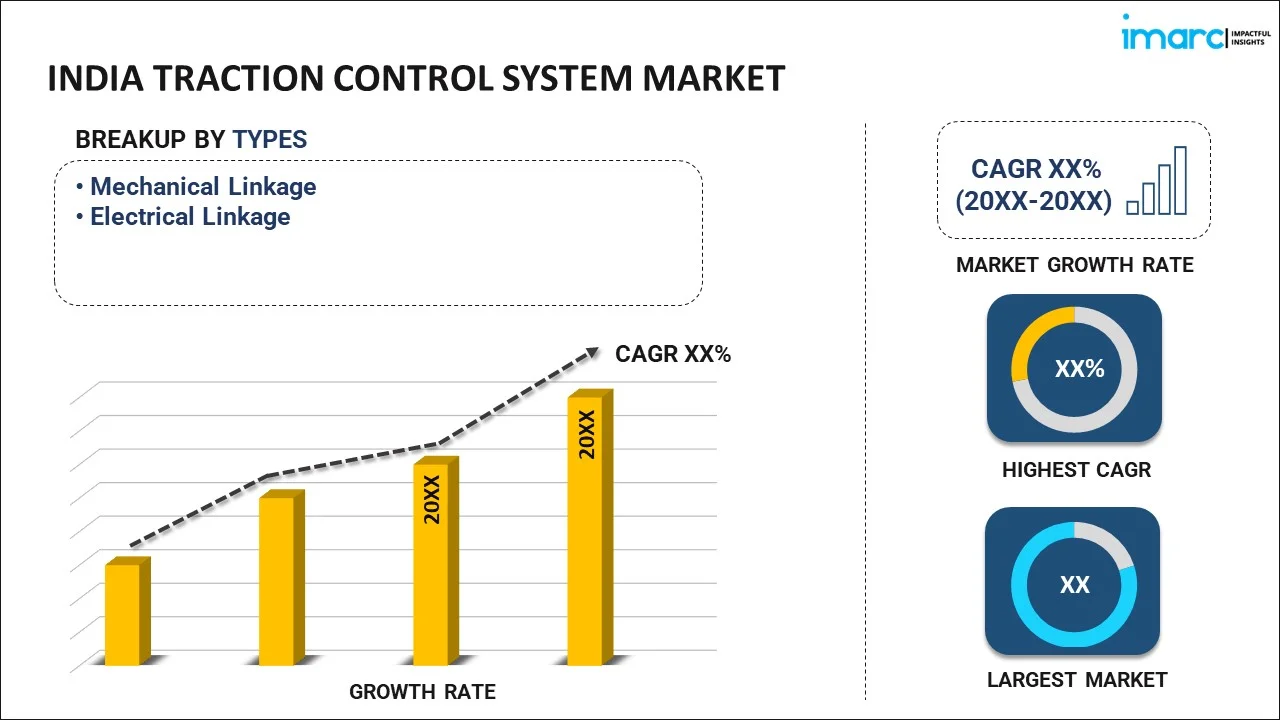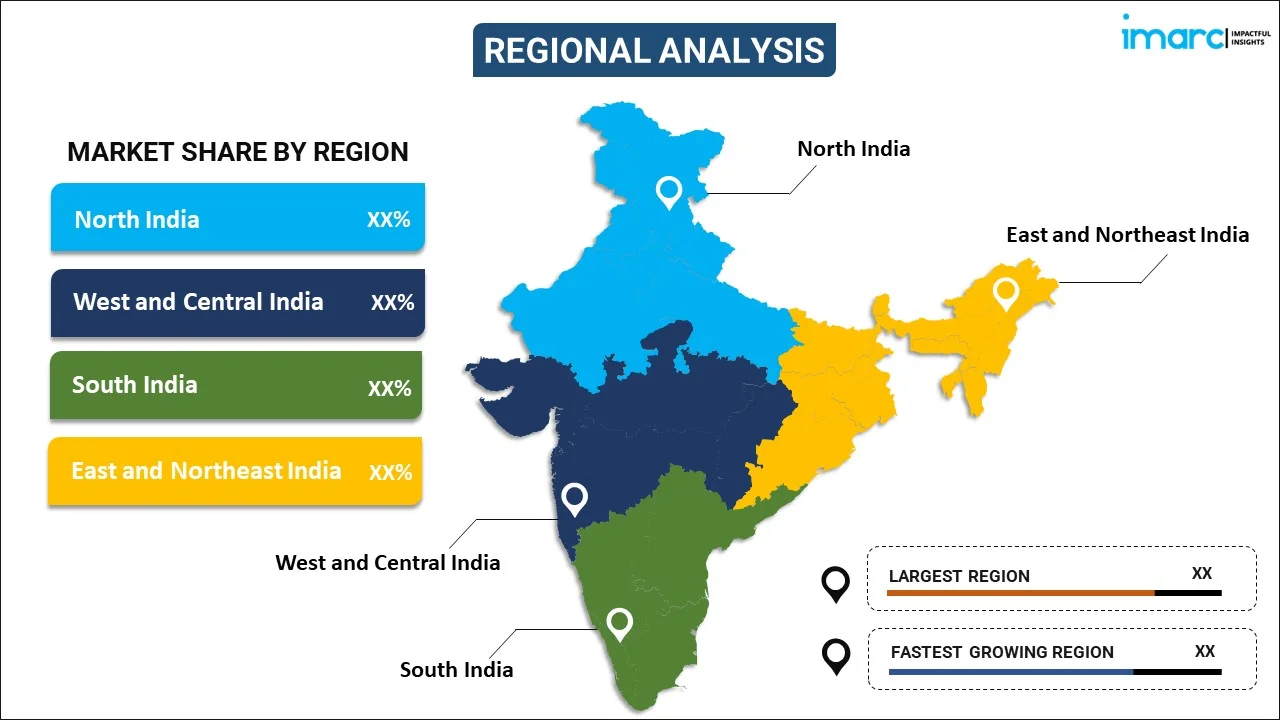
India Traction Control System Market Report by Type (Mechanical Linkage, Electrical Linkage), Component (Hydraulic Modulators, ECU, Sensors, and Others), Vehicle Type (ICE Vehicles, Electric Vehicles), Distribution Channel (OEM, Aftermarket), and Region 2024-2032
Market Overview:
India traction control system market size is projected to exhibit a growth rate (CAGR) of 5.70% during 2024-2032. The growing focus of government bodies for ensuring safer and more stable driving experiences across a diverse range of road and weather conditions is primarily driving the market growth.
|
Report Attribute
|
Key Statistics
|
|---|---|
|
Base Year
|
2023 |
|
Forecast Years
|
2024-2032
|
|
Historical Years
|
2018-2023
|
| Market Growth Rate (2024-2032) | 5.70% |
The traction control system (TCS) is an advanced active braking mechanism engineered to preserve the traction of a vehicle's tires on slippery surfaces and curves. Its primary function is to prevent tire slippage during acceleration or deceleration. Comprising components such as a hydraulic modulator, wheel speed sensors, engine throttle position sensors, stoplight sensors, and an electronic control unit (ECU), the traction control system assists drivers in maintaining control of their vehicles. Its objectives include accident prevention, skid avoidance, improvement of driving stability, and augmentation of road grip, particularly on slippery terrains.
India Traction Control System Market Trends:
The traction control system market in India is experiencing notable growth, propelled by the increasing demand for advanced automotive safety features and the rapid expansion of the automotive sector. TCS, an integral component of modern vehicle safety systems, plays a pivotal role in enhancing vehicle stability and preventing accidents, particularly in challenging driving conditions. Additionally, the Indian automotive landscape has witnessed a paradigm shift with a surge in the adoption of TCS across a wide range of vehicles, including internal combustion engines (ICEs) and electric vehicles (EVs). The traction control system market in the country is driven by the need to address challenges posed by diverse terrains and weather conditions prevalent in different parts of the country. As India experiences varying climates, from heavy monsoons to snow in certain regions, the implementation of TCS becomes crucial for maintaining optimal traction and preventing skidding. Besides this, government regulations mandating safety features in vehicles, coupled with increasing consumer awareness about vehicle safety, have spurred the demand for TCS in the Indian market. Furthermore, the rising disposable income of consumers has led to an increased preference for vehicles equipped with advanced safety technologies, including traction control system. The market's expansion is not only confined to passenger vehicles but also extends to commercial vehicles, where safety and stability are paramount. As automotive technologies continue to evolve, the traction control system market in India is poised for sustained growth over the forecasted period.
India Traction Control System Market Segmentation:
IMARC Group provides an analysis of the key trends in each segment of the market, along with forecasts at the country level for 2024-2032. Our report has categorized the market based on type, component, vehicle type, and distribution channel.
Type Insights:

- Mechanical Linkage
- Electrical Linkage
The report has provided a detailed breakup and analysis of the market based on the type. This includes mechanical linkage and electrical linkage.
Component Insights:
- Hydraulic Modulators
- ECU
- Sensors
- Others
A detailed breakup and analysis of the market based on the component have also been provided in the report. This includes hydraulic modulators, ECU, sensors, and others.
Vehicle Type Insights:
- ICE Vehicles
- Electric Vehicles
The report has provided a detailed breakup and analysis of the market based on the vehicle type. This includes ICE vehicles and electric vehicles.
Distribution Channel Insights:
- OEM
- Aftermarket
A detailed breakup and analysis of the market based on the distribution channel have also been provided in the report. This includes OEM and aftermarket.
Regional Insights:

- North India
- West and Central India
- South India
- East and Northeast India
The report has also provided a comprehensive analysis of all the major regional markets, which include North India, West and Central India, South India, and East and Northeast India.
Competitive Landscape:
The market research report has also provided a comprehensive analysis of the competitive landscape in the market. Competitive analysis such as market structure, key player positioning, top winning strategies, competitive dashboard, and company evaluation quadrant has been covered in the report. Also, detailed profiles of all major companies have been provided.
India Traction Control System Market Report Coverage:
| Report Features | Details |
|---|---|
| Base Year of the Analysis | 2023 |
| Historical Period | 2018-2023 |
| Forecast Period | 2024-2032 |
| Units | US$ Million |
| Scope of the Report | Exploration of Historical Trends and Market Outlook, Industry Catalysts and Challenges, Segment-Wise Historical and Future Market Assessment:
|
| Types Covered | Mechanical Linkage, Electrical Linkage |
| Components Covered | Hydraulic Modulators, ECU, Sensors, Others |
| Vehicle Types Covered | ICE Vehicles, Electric Vehicles |
| Distribution Channels Covered | OEM, Aftermarket |
| Regions Covered | North India, West and Central India, South India, East and Northeast India |
| Customization Scope | 10% Free Customization |
| Report Price and Purchase Option | Single User License: US$ 2699 Five User License: US$ 3699 Corporate License: US$ 4699 |
| Post-Sale Analyst Support | 10-12 Weeks |
| Delivery Format | PDF and Excel through Email (We can also provide the editable version of the report in PPT/Word format on special request) |
Key Questions Answered in This Report:
- How has the India traction control system market performed so far and how will it perform in the coming years?
- What has been the impact of COVID-19 on the India traction control system market?
- What is the breakup of the India traction control system market on the basis of type?
- What is the breakup of the India traction control system market on the basis of component?
- What is the breakup of the India traction control system market on the basis of vehicle type?
- What is the breakup of the India traction control system market on the basis of distribution channel?
- What are the various stages in the value chain of the India traction control system market?
- What are the key driving factors and challenges in the India traction control system?
- What is the structure of the India traction control system market and who are the key players?
- What is the degree of competition in the India traction control system market?
Key Benefits for Stakeholders:
- IMARC’s industry report offers a comprehensive quantitative analysis of various market segments, historical and current market trends, market forecasts, and dynamics of the India traction control system market from 2018-2032.
- The research report provides the latest information on the market drivers, challenges, and opportunities in the India traction control system market.
- Porter's five forces analysis assist stakeholders in assessing the impact of new entrants, competitive rivalry, supplier power, buyer power, and the threat of substitution. It helps stakeholders to analyze the level of competition within the India traction control system industry and its attractiveness.
- Competitive landscape allows stakeholders to understand their competitive environment and provides an insight into the current positions of key players in the market.
Need more help?
- Speak to our experienced analysts for insights on the current market scenarios.
- Include additional segments and countries to customize the report as per your requirement.
- Gain an unparalleled competitive advantage in your domain by understanding how to utilize the report and positively impacting your operations and revenue.
- For further assistance, please connect with our analysts.
 Inquire Before Buying
Inquire Before Buying
 Speak to an Analyst
Speak to an Analyst
 Request Brochure
Request Brochure
 Request Customization
Request Customization




.webp)




.webp)












